Debbie Young's Blog, page 19
March 3, 2021
The Comfort of Blankets
It’s good to welcome back the trusty Tetbury Advertiser for its first issue of 2021. Its February issue was cancelled due to lockdown, so as there is always a double issue for December/January, my March column was the first I’d written for them since November. Normal service has now been resumed – hurrah!
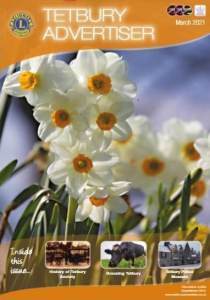 The Tetbury Advertiser springs back into action
The Tetbury Advertiser springs back into actionAlthough I don’t remember having a comfort blanket as a child, the older I get, the more I appreciate the concept. During this strange last year, when any source of comfort has been welcome, three kinds of blanket have caught my attention.
The Weighted Blanket
Ever since secondary school, I’ve enjoyed knitting and crocheting blankets. From the age of 11, we were bribed by house points into knitting six-inch squares. Our squares were made up into blankets, and sixth form volunteers took them to the local care home. We made so many blankets that we imagined the residents swamped under their weight.
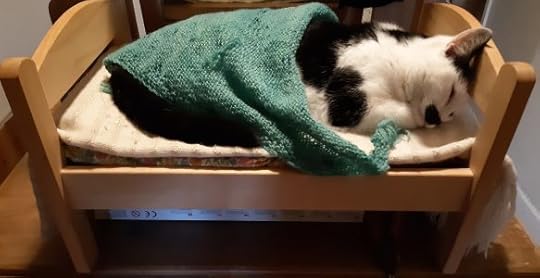 Bertie’s blanket is scaled down to suit him, as is his little bed
Bertie’s blanket is scaled down to suit him, as is his little bedBut I need not have worried: these days, weighted blankets are all the rage. They incorporate tiny bits of ballast to achieve the same heft as a cat on your lap. (That’s my chosen measure, not the designers’ – it sounds more appealing than saying 5kg.)
Originally developed to calm people with autism or anxiety, weighted blankets are scientifically proven to reduce blood pressure and heart rate.
According to the promotional blurb of the one I’ve just bought, they also “stimulate deep-touch pressure to release feel-good endorphins typically obtained from a long embrace”.
In the no-hug zone of Covid lockdown, no wonder weighted blanket sales have surged. (We bought ours from kudd.ly.)
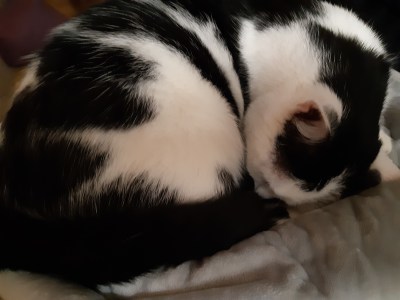 Bertie tests our new weighted blanket and is asleep within seconds
Bertie tests our new weighted blanket and is asleep within secondsThe Temperature Blanket
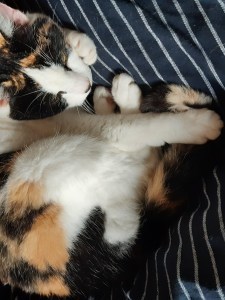 Dorothy finds brushed-cotton duvet covers equally satisfactory
Dorothy finds brushed-cotton duvet covers equally satisfactoryAnother recent discovery for me is the temperature blanket, created through the course of a calendar year. At the start of January, you choose a time and place to record the daily temperature and a colour palette to reflect each thermometer reading. Knitting a couple of rows a day in the right colour for that day’s temperature provides a dramatic visual record of the seasons.
If where you live the climate barely changes all year – the Canaries or Costa Rica, perhaps – choose a smaller scale to avoid a monochrome result, eg a different colour for each degree rather than for every five.
Not a problem that will trouble the knitters of Tetbury.
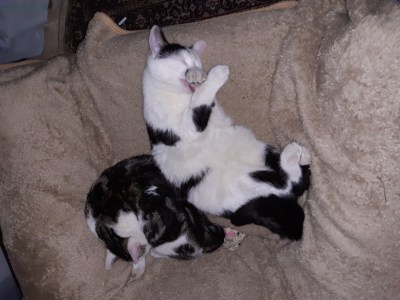 A fleece blanket also goes down well with Bingo and Bertie
A fleece blanket also goes down well with Bingo and BertieThe Lockdown Blanket
The lockdown blanket (not to be confused with the blanket lockdown) is the cousin of the temperature blanket. Again, working a few rows each day provides an oasis of meditative calm, as well as a record of a specific timeframe. Make from oddments you have in the house or choose a colour scheme that will lift your spirits.
For my lockdown blanket, I channelled the Scottish Highlands. Every time I picked up my needles and yarn the colour of mountains and glens, I was transported hundreds of miles north without leaving the safety of my home.
 Because sometimes there isn’t a cat around when you need one. This is my Scottish panda, bought at Edinburgh Zoo. Beneath my lockdown blanket, he’s wearing a kilt in the official panda tartan!
Because sometimes there isn’t a cat around when you need one. This is my Scottish panda, bought at Edinburgh Zoo. Beneath my lockdown blanket, he’s wearing a kilt in the official panda tartan!As we flip the calendar over to March, and with my first dose of vaccine in my arm, I’m looking forward to using a different kind of blanket altogether, once we’re all allowed out to play again: the picnic blanket. But in the meantime, I’m ordering another two weighted blankets to stop the family fighting over the first one.
So much for its powers of stress relief!
Click here to read the whole of the Tetbury Advertiser online for free.
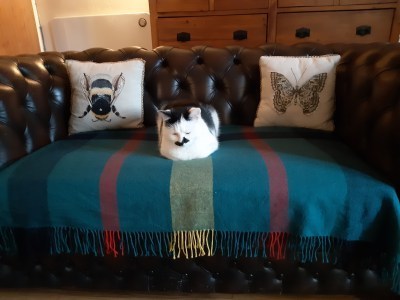 Bertie is fond of symmetry
Bertie is fond of symmetryIn Other News
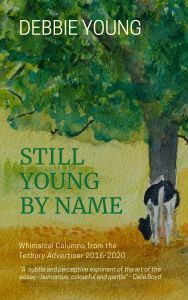 Another cover image by my talented father
Another cover image by my talented father The first volume covered 2010-2015.
The first volume covered 2010-2015.In the absence of a February edition of the Tetbury Advertiser, I took time out to collate all my columns from the previous five years into book form. Still Young By Name is the sequel to the first volume, Young By Name, which was published five years ago (no surprises there!)
Reading through my archive of columns, it struck me what an extraordinary five years we’ve just lived through, including the rise and fall of President Donald Trump, what seemed like the interminable process of Brexit, and of course the arrival of Covid-19.
I was slightly spooked when I discovered I’d written the first column in this new collection as I was recovering from flu.
The cover of the new book features another slice from my father’s rural watercolour painting that I used on the first book in this series. I do love the composition and calm mood of this painting.
I did wonder fleetingly whether it was wise to have a picture of a cow’s bottom beside the title, but it made me smile, and If it makes others laugh too, that’s fine by me!
The launch date for the ebook is 21st March (my parents’ 68th wedding anniversary, which seemed a good omen), and the paperback should be out shortly too. In the meantime, if you’re in the UK and it’s a Kindle ebook you’re after, just click here to pre-order. Other buying links to follow in my next post.
February 24, 2021
Travels with my Books #2: From the Caribbean to Exmoor with Helen Hollick

As a longstanding fan of the Pirates of the Caribbean ride in Disneyland, which I first visited in the original theme park in California at the age of eight, I was delighted to discover when I first met Helen Hollick that one of the series of historical novels she writes has as its hero a charming pirate Captain Jesemiah Acorne whose adventures often take him to the Caribbean.
The smash-hit Jack Sparrow films came much later than the theme-park ride, and I believe it’s the only case of the ride inspiring the film rather than the other way around.
Just like the ride and the films, Helen’s pirate novels plunge you into the Caribbean, amongst other places, including, closer to her home and mine, the rolling hills of Exmoor in Devon. I’m delighted to welcome Helen to my blog today to tell us all about her travels with her books!
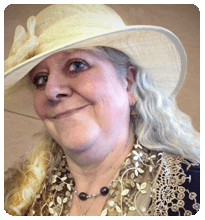 Helen Hollick, author of historical, fantasy and contemporary fiction
Helen Hollick, author of historical, fantasy and contemporary fictionHello, Helen, and welcome! To set the scene, could you please your books’ setting on the globe
Now, this is going to be one of those ‘which one shall I use?’ moments. You see, my Sea Witch Voyages are set in various locations because they are, well, voyages aboard a ship – the Sea Witch – with a pirate and his crew. Captain Jesamiah Acorne finds himself getting into trouble from Jamaica to Devon, from Virginia to the Bahamas via Cape Town, South Africa! However, as it is rather cold here in the UK at the moment, let’s head for somewhere warm …Port Royal, Jamaica!
Please briefly describe the books you have set in the Caribbean.
 When The Mermaid Sings is a prequel novella to my Sea Witch Voyages series telling the story of how Jesamiah fled his home in Virginia because of his bullying elder half-brother. He is seeking a sailor friend of his father – but ends up finding more than he bargained for: the ghost of his father, Captain Morgan, a mermaid – and the start of a life of piracy!
When The Mermaid Sings is a prequel novella to my Sea Witch Voyages series telling the story of how Jesamiah fled his home in Virginia because of his bullying elder half-brother. He is seeking a sailor friend of his father – but ends up finding more than he bargained for: the ghost of his father, Captain Morgan, a mermaid – and the start of a life of piracy!
What makes Port Royal, Jamaica, such a great setting for fiction?
Back in the late 1600s Port Royal was known as ‘The Wickedest Town In The World’ because of all the pirates and privateers who dropped anchor in the harbour. So much looted Spanish treasure was taken there, even servants were well off financially.
Unfortunately, in 1692 a massive earthquake destroyed most of the town and killed thousands of people.
The harbour remained, but the town was never rebuilt – Kingston was established on the other side of the bay instead. I wanted to make When The Mermaid Sings a partial ghost story, so Port Royal was an ideal location for Jesamiah to go to.
What is your relationship with Jamaica and how much of your life have you spent there?
None at all! I’ve never been to the Caribbean – however, later in the series (Ripples In The Sand, Voyage Four and On The Account, Voyage Five,) I bring Jesamiah and his wife (he’s grown up since When The Mermaid Sings) to Devon, England, so I have many scenes set in and around Barnstaple on the North Devon coast, and on Exmoor, both of which I know very well as I live nearby!
What is special about the people native to Devon?
May I mention one real person in particular? My previous editor, Jo Field, now retired, used to live at Instow not far from Barnstaple. I used to live in East London, so visited her twice a year for a writer’s chinwag and a holiday. It was because of where she lived that I decided to bring Jesamiah (and his ship, Sea Witch) to Devon, and consequently I also fell in love with the place. In 2012 we won the lottery (on the opening night of the London Olympics) and decided to move to Devon.
I hadn’t realised, all those times that I came on the train to visit Jo, travelling from Exeter to Barnstaple, that I would be passing right by the house I now live in!
I can see a section of the Tarka Line railway as it winds through the Taw Valley from my bedroom window – it’s like looking down on my very own real model railway!
If your protagonist or other characters come from elsewhere, what challenges do they face dealing with the local people?
Jesamiah was born in Virginia, the son of an English privateer and a Spanish mother. I rather assume he would have a typical Colonial Virginian accent – which is quite far removed from the Devon dialect. When he first sets foot ashore at Appledore he has a bit of a job understanding some of the Devonshire words, as the following excerpt from Ripples In The Sand shows:

The rain had started to lash down as Jesamiah kicked open the door to the Full Moon and negotiated his way through, taking care not to scrape or bump Tiola enfolded in his arms and wrapped in a swathe of blankets.
The landlady, a homely woman in her early thirties, bustled from behind the counter concern bubbling from her as energetically as the wisps of hair escaping beneath her lace cap. “Oh my, the poor maid looks nigh on exhausted.” She shooed away an elderly man sitting before the fire, ushering him to another seat. “Set ‘er down ‘ere Cap’n. The girl’s lighted the vire upstairs an’ put a pan in t’warm the sheets. It be a nice corner room overlookin’ the harbour, it’ll do you cheerily.” She pursed her lips and tutted. “I suggest you keep them shutters closed ‘cross the smaller side winder though, sir. The view o’ the drang oft’n be not respec’able.”
Grumbling beneath his breath the old man, as bald as a coot but with a great bush of a white beard, took his half empty tankard of cider along with his pipe and baccy pouch, and shambled to a settle near the window. He sat, sniffed disdainfully and wiped his nose on the cuff of his coat, which he ostentatiously drew closer around his chest, then turned the collar up against the draught. “It be goin’ t’snow on them moors,” he predicted. “Prob’ly ‘ere an’ all. Vruzzen in us’ll be.”
“Drang?” Jesamiah queried, not recognising the word and struggling to understand the conversation. Tiola had a slight Cornish burr, but his ear was not attuned to this unfamiliar Devon dialect. He shrugged, guessed he would pick it up soon enough.
The old man chuckled. “Nowt wrong with Cock Lane tha’ an ‘ealthy man can’t be makin’ good use ov.”
Getting the gist of the statement Jesamiah raised an eyebrow, was about to repeat his ‘drang’ question, but let it pass.
The typical ‘pirate speak’ that we think of (‘arr’ and such) actually originates from Robert Newton who played Long John Silver in Treasure Island. He was a Cornishman so improvised his West Country accent. Many sailors – and pirates – came from Cornwall, Devon and Bristol, so all had a similar accent, including Sir Francis Drake and Sir Walter Raleigh.
What are the distinguishing features of one of the destinations you write about in terms of geography, geology, flora, fauna or any other detail you care to mention?
I will take us to Exmoor, as I know it better than Jamaica. (Although as I write this, in mid-January, I believe it is snowing up on the moors, so Jamaica would be warmer!)
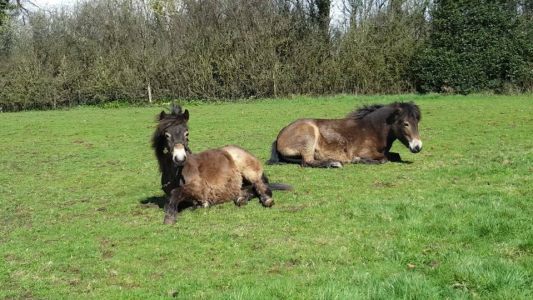 Wild Exmoor ponies
Wild Exmoor poniesExmoor is a wild place – it is even home to the wild Exmoor ponies (we have three moorland bred ponies of our own on our farm). The moor was made famous by RD Blackmore’s Lorna Doone, and indeed I have borrowed the Doones and used their fictional descendants in Ripples and Account.
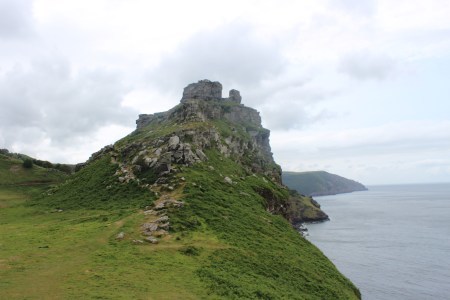 Valley of the Rocks, Exmoor (photo copyright Cathy Helms)
Valley of the Rocks, Exmoor (photo copyright Cathy Helms)The north coast of Exmoor rises steeply from the sea, giving glorious views, although usually also windswept ones. There is a particular geological features of rocky outcrop that looks a little like the ruins of a castle. Many Victorian poets visited this incredible geological feature, Robert Southey in August 1799, was impressed, describing it as ‘… the very bones and skeletons of the earth’.
In On The Account, Jesamiah’s wife, Tiola Oldstagh (who is actually a white witch) spends the night on Exmoor, described in the following extract:
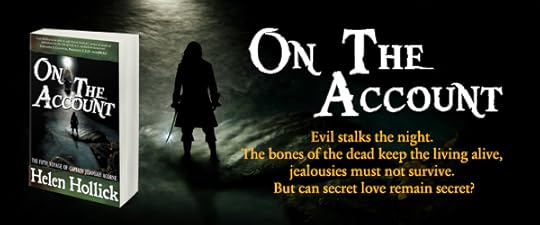
An hour after dusk had settled into the star-frosted night, Tiola fed another stick into her meagre fire. The wood was damp and it gave off more smoke than heat, but it was better than nothing up here on the windswept openness of Exmoor’s exposed coast. She was sheltered in the hollow behind the magnificent tor of rocks that separated the valley from the sea, three hundred feet below. A place steeped in myth, legend and mystery. It was said that the Devil had resided in a castle of rock with his many wives, but angered at their infidelity he had blasted the eyrie to pieces. All that remained were the bare, jagged bones; the skeleton rocks piled stone upon stone. Nothing but a story, an old tale to explain the strangeness of a natural glacial formation – the Devil did not exist, but Tiola was aware that something was lurking out there in the darkness, watching her.
The stick flared into flame and the light caught the glint of an eye a few yards off. Tucking a loose strand of her black hair behind her ear, Tiola calmly added more wood to the fire and smiled to herself. This was the Valley of the Rocks, known also for the herds of feral goats that thrived on the coarse sea-salt grass. A huffed snort and a stream of misted breath evaporated into the cold air. A wild pony then, not a goat; one of the distinctive two-thousand-year-old Exmoor breed with their thick, weather-resistant, shaggy coats and light-coloured muzzles. Had she borrowed such a pony from the stables at Tawford Barton she would be at her destination by now, but her mission was secret and she wanted to know who had been watching her these past seven days, and had followed her, this night, up on to the moor.
What are your top tips for any readers planning to travel to the setting of your book?
To Jamaica – watch out for pirates, and parrots who have learnt to sample the beer from kegs in the taverns … of course, that only applies if you can also time travel back to the 1690s!
To Exmoor – take stout walking boots and something warm and dry to wear. Even on sunny days it is windy up there… but breathtakingly beautiful.
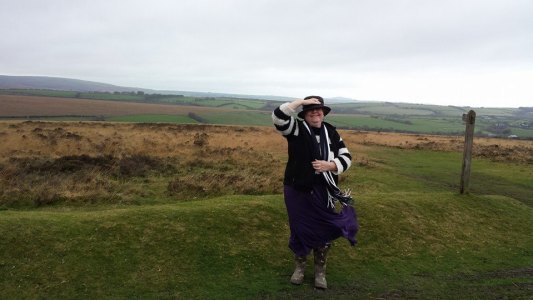 Helen Hollick hangs on to her hat on Exmoor!
Helen Hollick hangs on to her hat on Exmoor!‘Only in Port Royal…’ name three things that could only happen there!
In November 1720 you would have seen the trial of Anne Bonney and Mary Reed, the female pirates who sailed with Calico Jack Rackham. Mary died in gaol, Rackham was hanged, but no one knows what happened to Anne.Time travel back a little further, and you could meet Captain Morgan, who was a privateer against the Spanish, but then became Governor of Jamaica … and yes, he is the Captain Morgan who gave his name to the rum!‘Jamaica Gold’ – pineapples – used to be highly valuable because Jamaica was one of the few places where they grew, were easy to harvest and transport back to the Colonies – and even England.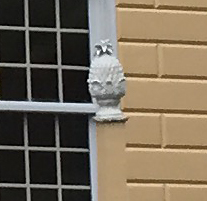 Spot the pineapple!
Spot the pineapple!Because of its rarity, and the difficulty in keeping it fresh during a long sea voyage, the pineapple was regarded as the food of the wealthy. For the well-to-do, ‘visiting’ either for afternoon tea, or to dine, was one of the prime sources of entertainment. Social intercourse was a way to show off what you had, and an essential way to keep up with the local gossip and news. Status, and the ability to show it, was an essential element. Keeping up with the Joneses is nothing new!
The Colonial hostess would seek subtle ways to brag about what she had, and would take great pains to outdo her neighbours. Elegant furniture, sumptuous and elaborate gowns, exquisite china and silver tableware, fine linens, expensive tea… Food was displayed on platters and arranged in elaborate pyramid styles, often dripping with sugar. Dinner was a culinary delight and always extravagant.
The laid table would be kept as a surprise, behind closed doors until the moment to reveal all came. Fresh fruit was a grand thing to be displayed, but topping it all would be the pineapple. It was rare, expensive, and wonderful to look at, touch – and eat. It was the crowning celebrity-status glory of the feast.
Have you ever noticed stone pineapples outside houses? To have one on display at a dinner party meant you’d made it to the top of the tree – but fruit doesn’t stay fresh for long, so it soon became popular to place stone ones on gateposts and such to indicate a wealthy household, and also as a sign of welcome. So keep an eye out for the not-so-humble pineapple!
Are there any other authors’ books with the same setting that you’d like to recommend?
Dozens, but I am going to cheat and select Jamaica Inn by Daphne du Maurier. It was – still is – a real pub, on Bodmin Moor, Cornwall, named by the Trelawney family who founded it in 1750, from the money they made in Jamaica – and for the smuggled rum which passed through on its way from Cornwall to London. Du Maurier wrote her story after being stranded there in thick fog one night.
Where is your latest book set?
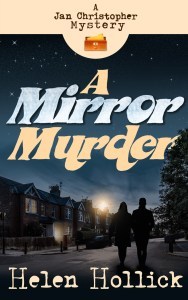 Helen’s latest novel takes us to Chingfod, Essex
Helen’s latest novel takes us to Chingfod, EssexSomewhere completely different! A north-east London suburb, Chingford, where I was born in 1953, brought up and worked until the early 1980s. A Mirror Murder is a cosy mystery set in 1971 with the lead character, Jan Christopher, working (as I did!) as a library assistant.
I decided to give writing a murder mystery a go after being inspired by Debbie’s wonderful Sophie Sayers Series! (I confess, I am a little in love with Hector – although this might be because he owns a bookshop!)
Here’s an introduction to A Mirror Mystery:
Eighteen-year-old library assistant Jan Christopher’s life is to change on a rainy Friday evening in July 1971, when her legal guardian and uncle, DCI Toby Christopher, gives her a lift home after work. Driving the car, is her uncle’s new Detective Constable, Laurie Walker – and it is love at first sight for the young couple.
But romance is soon to take a back seat when a baby boy is taken from his pram, a naked man is scaring young ladies in nearby Epping Forest, and an elderly lady is found, brutally murdered…
Are the events related? How will they affect the staff and public of the local library where Jan works – and will a blossoming romance survive a police investigation into murder?
Where will your next book be set?
Which one? *laughs* I really must write the sixth Sea Witch Voyage – which starts in Gibraltar, and will feature Exmoor and Devon again – but also Spain, possibly Portugal and France as well, I’m not sure because I’m never quite certain where trouble will lead my Jesamiah…
I am also writing the second in my planned Jan Christopher Mystery series: this one will be set in Devon at Christmas. Great fun with lots of snow and murdered victims.
I’ll look forward to reading them all, Helen! Thank you so much for taking us on this virtual journey around your books today.
(All images in this post are the copyright of Helen Hollick unless otherwise stated)
ALL ABOUT HELEN HOLLICK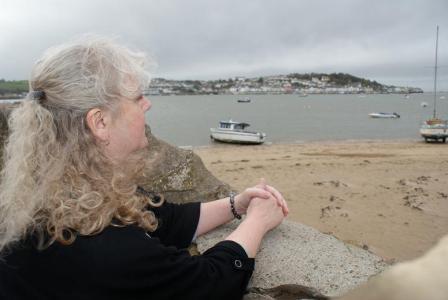 Helen Hollick taking inspiration from atmosphere at Instow, Devon
Helen Hollick taking inspiration from atmosphere at Instow, DevonHelen Hollick and her family moved from London in January 2013 after finding an eighteenth-century North Devon farm house through being a ‘victim’ on BBC TV’s popular Escape To The Country show. The thirteen-acre property was the first one she was shown. She loves her new rural life, and has a variety of animals on the farm, including hens, ducks, geese, dogs, cats, Exmoor ponies and her daughter’s string of show jumpers.
First accepted for publication by William Heinemann in 1993 – a week after her fortieth birthday – Helen became a USA Today Bestseller with her historical novel, The Forever Queen (titled A Hollow Crown in the UK) with the sequel, Harold the King (US: I Am The Chosen King) being novels that explore the events that led to the Battle of Hastings in 1066. Her Pendragon’s Banner Trilogy is a fifth-century version of the Arthurian legend, and she also writes a pirate-based nautical adventure/fantasy series, The Sea Witch Voyages.
Despite being impaired by the visual disorder of glaucoma, Helen is now branching out into the cosy mystery genre with a new series of quick-read novellas. The first in her Jan Christopher Mysteries series, set in the 1970s, is out now. A Mirror Murder incorporates often hilarious memories of working for over a decade as a library assistant.
Her non-fiction books are Pirates: Truth and Tales and Life of A Smuggler. She occasionally gets time to write…
Click the link to order A Mirror Murder in ebook or print: getbook.at/MirrorMurder
Visit her website: https://helenhollick.net/
Like her Amazon Author Page: http://viewauthor.at/HelenHollick
Subscribe to her newsletter: http://tinyletter.com/HelenHollick
Follow her on Twitter: @HelenHollick
Next month: join Alison Morton for a trip to the fictitious land of Roma Nova, evolved from the ancient Roman empire in her series of alternative history novels – and for a trip to France in her new contemporary thriller, Double Identity.
(To receive each new post in your email inbox, just type your email address in the box beneath the “Follow Blog” button in the sidebar to the right of this post.)
February 11, 2021
The Healing Power of Houseplants
In this month’s issue of the Hawkesbury Parish News, I create my own indoor spring
In the middle of a grim January in which fog and frost have rendered the local Cotswold landscape monotone, I crave the sight of colour. I know that even just looking at greenery is scientifically proven to offer mental health benefits, but I’m unable to buy any from shops as they’re not essential foodstuffs. So I ask on the local Facebook Second-to-None group whether anyone has spare houseplants in need of a good home, ie mine.
Immediately a flurry of kind offers pops up, including some plants rumoured to be unkillable.
By all accounts, the spider plants and aloe veras are likely to outlive me. I must remember to provide for them in my will.
Further investigation shows that house plants can serve other functions besides lifting your spirits, such as clearing toxins from indoor air. No less than NASA has run tests of three common houseplants to see which was best at removing formaldehyde, with spider plants emerging the clear winner.
Indoor pollution prevention in a plant pot should be handy on the International Space Station, not to mention making the place feel more homely.
Apparently certain palms, ferns, peace lilies, ivy and rubber plants are even better at extracting chemical vapours indoors, although I’m not sure what they do with them once they’ve collected them. Interior design specialists credit houseplants with reducing headaches, sore throats and other minor ailments in the workplace and the home.
Aloe vera is another plant no home should be without. Keep one by the cooker as a first aid measure and apply the juice of a leaf to burns to speed healing. Aloe vera is also anti-inflammatory, promotes circulation, and inhibits the growth of bacteria. A multi-million-dollar industry, Forever Living, has been built on aloe-vera-based products.
According to Marina Pogose, aloe vera “grows like the devil”, so I’m guessing the company never runs out of stock.
A few days after I’ve distributed my new houseplants about my home, I visit my GPs’ surgery for my annual health MOT, where I’m startled to learn that I weigh the same as I did at the start of the first lockdown and my blood pressure and pulse, which were healthy enough then, have actually improved. I’ve scarcely been out of doors for a year, and I’ve done very little physical exercise, so there can only be one reason that I’m doing so well now.
When I find out which of my new houseplants is responsible, I’ll let you know.
With grateful thanks to Chris, Jenny, Jill, Kate, Maia, Marina and Penny for all their kind offers of plants.
IN OTHER NEWS
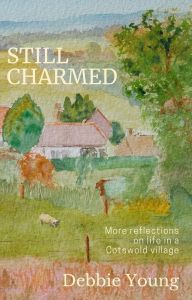
To celebrate having lived in Hawkesbury Upton for thirty years, I’ve just published in paperback and as an ebook Still Charmed , my latest collection of columns for the Hawkesbury Parish News , written from 2016-2020 – an extraordinary period that saw huge change around the world. The book is available to buy online via the links below.
Buy the ebook for your preferred ereader Paperback
February 5, 2021
Introducing a New Series of Author Interviews: Travels with my Books #1 – To Fiji with BM Allsopp
Although I’ve lived in the same cottage in a quiet corner of the Cotswolds for thirty years, I’m better travelled than this statement might suggest.
By the age of 9, I’d made a road trip with my family across the USA from Philadelphia to Los Angeles, visiting more states than many US citizens.Before I left school, I was a seasoned pan-European solo traveller by train and plane, flitting between Frankfurt, where I lived aged 14-18, to England and the Netherlands to visit family and friends.By the time I was 40, my career in journalism and PR had paid me to travel to many European cities and to join conventions in Hong Kong and on a Caribbean cruise ship.Since 2000, I’ve spent many holidays Greek island-hopping in the small sailing yacht in which we owned a small share (more affordable than it sounds – just £3k!) or touring Scotland and northern mainland Europe in our camper van.Reading to Travel While my wanderlust has abated as I’ve got older and have fewer places left on my bucket list, I still like to “travel by book”, reading about distant lands, whether in fiction in the form of novels and short stories or in non-fiction via travelogues and memoirs.
While my wanderlust has abated as I’ve got older and have fewer places left on my bucket list, I still like to “travel by book”, reading about distant lands, whether in fiction in the form of novels and short stories or in non-fiction via travelogues and memoirs.
I enjoy revisiting places I’ve been and which I love (eg to the Scottish Highlands and Islands in Compton Mackenzie’s Whisky Galore), and I also welcome the chance to virtually visit countries I’m never likely to reach in person (eg to Iceland with Bjorn Larssen in Storytellers)- such as anywhere that is host to venomous snakes! While not a habitual reader of fantasy, I’ve also had some pleasurable trips to places that are the stuff of myth, from Homer’s Odyssey to Lucienne Boyce’s To the Fair Land.
While so many of us face continuing travel restrictions, I thought it would be fun this year to make the theme of the monthly guest posts on my blog “Travels with my Books”, interviewing author friends all around the world about the settings of their books.
First Stop: Fiji! BM Allsopp. author of the Fiji Islands Mysteries
BM Allsopp. author of the Fiji Islands MysteriesI’m delighted to begin the series with about as distance a destination as possible from my English village home: Fiji, in the company of B M Allsopp (Bernadette).
I first discovered her compelling and colourful Fiji Islands Mysteries when Bernadette emailed me out of the blue to offer a review copy, having discovered my English village mysteries on the internet. Despite the distance, and although we’re unlikely ever to meet in person, we have become firm friends. I so enjoyed the chance her first book, Death on Paradise Island, gave me to learn about Fiji through the first adventure of her Inspector Josefa Horseman and his South Asian sidekick Sergeant Singh that I’ve now read all of her books and eagerly anticipate new additions to her series.
I hope my conversation with Bernadette will encourage you to take a virtual trip to Fiji too. Join her mailing list at www.bmallsopp.com and you can even get two free books to sample her work!
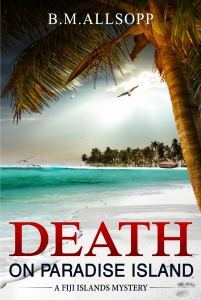 The first in BM Allsopp’s Fiji Island Mysteries
The first in BM Allsopp’s Fiji Island MysteriesHi Bernardette and welcome to my blog. Can we please kick off by pinpointing your books’ setting on the globe?
Spin your globe to the vast blue segment of the Pacific Ocean. Trace down the 180-degree meridian to south of the equator and you’ll find Fiji above the Tropic of Capricorn. You’ll notice the International Date Line diverts east from the meridian here, so that Fiji, some other islands, New Zealand and part of the Russian Far East are in the same time zone. The sun truly rises in Fiji first!
What a neat claim! Next, can you please give a nutshell summary of your books?
My Fiji Islands Mysteries are police procedurals featuring Inspector Joe Horseman, washed-up Fiji rugby star, and Sergeant Susila Singh, a driven woman defying the odds. Their partnership grows as they strive for justice in their fragile paradise.
What makes Fiji such a great setting for your stories?
My stories wouldn’t exist without Fiji because they have sprung from my own experiences there. As a huge fan of exotic crime fiction, I aim to give readers the same sense of discovery that I enjoy with authors like Alexander McCall Smith (No 1 Ladies Detective Agency series set in Botswana).
What is your relationship with Fiji, and how much of your life have you spent there?
I lived in the South Pacific islands for 14 years, including four in Fiji, where I taught at the University of the South Pacific in Suva. I love Fiji!
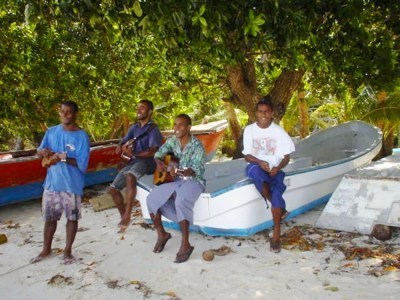 Fijians have an impressive seafaring heritage
Fijians have an impressive seafaring heritageWhat is special about the people native to Fiji?
The first settlers were unsurpassed navigators who arrived around 3,500 years ago from islands to the west, perhaps from as far as New Guinea. Indigenous Fijians now comprise 58% of the population and own most of the land through a traditional hierarchy of hereditary chiefs. Fijians are courteous and dignified while also vital, smiling and friendly. Renowned in the nineteenth century for the quality of their boats and houses, many traditional skills still thrive, as do elaborate ceremonials surrounding the chiefs.
Does your protagonist or other characters come from Fiji?
My main series characters are Fijians from different ethnic backgrounds. The only foreign series character is the Australian pathologist, Dr Matt Young, who has lived in Fiji for over 20 years. His late wife was Fijian and he considers Fiji his home.
 The collared lory – one of the Fiji Islands’ many beautiful birds
The collared lory – one of the Fiji Islands’ many beautiful birdsWhat are the distinguishing features of Fiji in terms of geography, geology, flora, fauna or any other detail you care to mention?
Most of Fiji’s 320 or so islands are of volcanic origin and fringed by coral reefs. The biggest four islands have rugged mountains and support rainforest, grassland and wetland habitats for diverse plants and animal species. Although native mammals are restricted to just four kinds of bats, a number of beautiful birds, reptiles and plants are found only in Fiji. Of these, the red shining parrot and the crested iguana feature in my first book, Death on Paradise Island.
What are your top tips for any readers planning to travel to the setting of your book?
 With over 320 islands, Fiji’s transport network includes seaplanes
With over 320 islands, Fiji’s transport network includes seaplanesAs Fiji is economically dependent on tourism, the people are suffering terribly from the current Covid-19 travel restrictions. When the world opens up again, why not escape to these glorious islands? Here are my top tips for when you do!
Unless you thrive on hot and very humid weather, I recommend the months from April to October, when the temperatures are moderate, cool breezes blow and the risk of storms and cyclones is small.Fiji offers much more than sand and coconut palms. You can gently snorkel over a dazzling coral reef, visit a rural village school, scuba dive with feasome sharks, play golf… and much more.Don’t spend all you time in one of the big international hotels, lovely though they are. If you hate backpacker beach huts, there are 5-star boutique island getaways where you’ll experience traditional culture and still luxuriate.Don’t hesitate to chat to the locals. Wherever you go, Fijians will always be welcoming and wonderfully friendly.“Only in Fiji” – name three things that could only exist/happen there.
Uniformed police officers direct traffic wearing a starched white skirt (sulu) with a saw-tooth hem. The dress uniform of the Fiji Military Forces is similar.The whole country stops when the Fiji rugby team is playing an international game. Except on remote islands with no TV or Internet reception, the entire population is glued to a screen.Fijians readily acknowledge their ancestors were feared cannibals not so long ago. They are not at all embarrassed to talk about such customs but are very thankful times have changed. A Fijian police parade shows off their striking uniform
A Fijian police parade shows off their striking uniform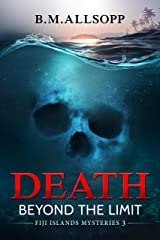 The latest in the series
The latest in the seriesWhere is your latest book set?
Death Beyond the Limits, the third in the series, is set in Fiji’s capital of Suva, the beautiful mountainous island of Ovalau and at sea.
Where will your next book be set?
Fiji – the precise location is still a mystery.
Thank you so much for that lightning introduction to Fiji, Bernadette, and thanks also for kindly allowing me to share the following extracts from your books for a further taste of Fiji.
Start Your Journey to Fiji Here!
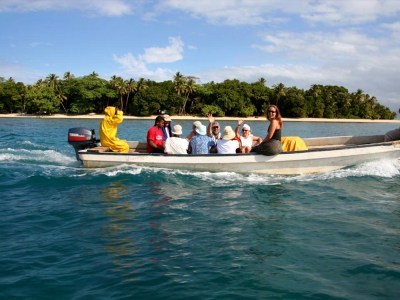
The Prologue from Death on Paradise Island
 The first in BM Allsopp’s Fiji Island Mysteries
The first in BM Allsopp’s Fiji Island MysteriesA crested tern swooped down to the edge of the fringing reef, attracted by the flutter of white in the water lapping the exposed coral. But the tern flew away disappointed, for this was no fish, just a scrap of cloth. The cloth was torn from the uniform worn by all the Paradise Island staff for the marine reserve celebrations: tailored white tunic patterned with black coconut palms and rugby balls, worn with a black sulu, the Fijian wraparound skirt.
If the tern investigated the white flapping further, it would find the cloth scrap still partly attached to the tunic and the girl wearing it. She had washed in from the sea and was caught by the jagged shelf below the coral overhang. The delicate coral was merciless, abrading her golden-brown skin as the waves tossed her back and forth until the tide retreated.
So it was a small hermit crab who first discovered the dead body of Akanisi Leletaku, who had so proudly arranged the floral decorations for the festivities. The crab picked its way over her uniform and scuttled into her open mouth, where it began to feed on the soft tissue.
© B M Allsopp 2021
Detective Horseman tells the story behind his name – Death on Paradise Island
‘But I like my ancestor’s story better. Legend has it that he was a survivor of a ship wrecked on a reef off Vanua Levu. A few men managed to get ashore, where they were clubbed and prepared for the ovens.’ He paused, trying to gauge if they were really interested.
‘Come on! Truly? I’m sure all those cannibal stories are highly exaggerated for ghoulish tourists,’ McKenzie protested, ever the diplomatic host.
Horseman glanced at Adi Litia, who calmly replied, ‘Not at all, Ian. The victors ate all the enemy killed in battle, for a start. The chiefs’ cooks roasted anyone put to death for offending the law or the chief too. There were even raiding parties whose main purpose was to bring back meat. All Fijians praise God for sending the brave Christian missionaries to deliver us from those evils.’ She put a forkful of rare steak into her mouth and chewed it with strong white teeth.
McKenzie subsided into a stunned silence.
Horseman went on. ‘My ancestor clung to some timber and washed up in a different bay. He came to on the beach as he was being nuzzled by a horse, part of his ship’s cargo. The club-wielding warriors were keeping their distance, terrified. You’ve got to remember, none of them had ever seen a land animal bigger than a pig.
‘The chief’s men reported the wreck to him, and he came along to inspect the flotsam and jetsam for himself. It was true love at first sight. The chief would have given anything for the horse—guns, war canoes, slaves, women—anything and everything. My ancestor sensed the chief’s desire and stayed close to the horse for protection. He stroked and soothed the traumatised animal, and kept repeating the word Horse, trying to placate the Fijians. Desperate to convince the chief of his value, he climbed on the horse’s back and showed off his riding skills before the gob-smacked Fijians. Up and down the beach. Bareback. Trotting, galloping, wheeling and rearing. Impressive.
‘The upshot was my ancestor became the chief’s horseman, groom and riding instructor. He was given a house and at least one wife, and lived long enough to have several children. Only one son had children himself, and he adopted his father’s title as a surname, which has been passed down in the European way until today.’
‘Are you sure you’re not making this up?’ asked Pat McKenzie, suspiciously. Another glare from her husband.
‘No, but it might have been made up a long time ago. Who knows now? Six generations have passed since then. But we’re here, and my ancestor’s word for the animal was horse, so I guess he was from Britain, Ireland or America.’
‘The first horse in Fiji—a fabulous story.’ McKenzie spoke softly, awed.
Adi Litia laughed. ‘Fijians believe it. I hope it’s true.’
‘There are a lot of us now, and we’re officially classified in Fiji as kailoma, part-European. The leaves on my branch are mostly Fijians, so I look Fijian. I’ve cousins in Australia who look completely European. We’re all Horsemans, though. Or should it be Horsemen? Our clan can never agree on that, especially the women.’
© B M Allsopp 2021
Inspector Horseman arrives at Tanoa village, where a man has been murdered – Death By Tradition
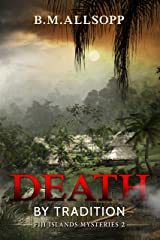 The second in the series
The second in the seriesMist shrouded the river, thinning as it rose to the hilltops. The hazy river bank opposite curved to the point where the bridge crossed.
To the right stood clusters of houses and a church. Further up the slope was a terrace with a school and a grassed rectangle with bamboo posts at either end. This would be the rara, the ceremonial space that in small villages doubled as a rugby field, both functions equally vital. Here and there were washing lines and small sheds. At the beach below the bridge, women washed clothes, slapping them rhythmically on the smooth river stones. Others tended fish traps, watched closely by a couple of thin dogs. A typical backblocks village—picturesque, placid, dull. But this one harboured an unusual and dangerous killer.
To the left of the bridge, the land rose steeply to a high outcrop of rock, a near-vertical cliff. The stone at the top had been shaped, maybe boulders hauled up to increase the height. Horseman recognised the ruins of a precolonial hill fort. His hackles rose as he gazed through the mists of time at bloody battle scenes. Rough battlements would have protected the Tanoa defenders hurling spears, shooting arrows, throwing missiles with deadly accuracy. What better site to spot attackers from down river? What better site from which to repel them?
© B M Allsopp 2021
For More Information & Free Books Download this prequel for free when you join BM Allsopp’s mailing list
Download this prequel for free when you join BM Allsopp’s mailing listTo find out more about B M Allsopp and her Fiji Island Mysteries, visit her website at www.bmallsopp.com. Her website also includes a gallery of beautiful photos of Fiji and a section of useful resources.
If you join her mailing list at www.bmallsopp.com, you can even get two free ebooks!
You can also follow her on Facebook at www.facebook.com/B.M.Allsopp.author/ and on Twitter at @bmallsopp.
Next month: join Helen Hollick for a piratical journey around the Caribbean!
(To receive each new post in your email inbox, just type your email address in the box beneath the “Follow Blog” button in the sidebar to the right of this post.)
January 28, 2021
Remembering Stuart Sharrock
In this week’s post, I pay tribute to the late Dr Stuart Sharrock, a highly intelligent and generous man who made a lasting impact on my life.
 The dated image of the phone on the cover makes me realise how long ago I was part of its editorial team,
The dated image of the phone on the cover makes me realise how long ago I was part of its editorial team,The first job that I really enjoyed was working for a trade journal, Telecommunications, when I was in my twenties. I knew nothing about technology and cared less, but really wanted to work in magazine publishing and journalism, and the advertised post of Editorial Assistant seemed a good starting point.
When I discovered the office was in a vibrant part of central London, just round the corner from Buckingham Palace, in a mews behind a high-profile street in Belgravia, an easy commute from my south London flat, I was even keener to apply.
Quickly taken under the wings of both Dr Stuart Sharrock as Editorial Director and Editor Denis Gilhooly (a fellow English graduate), by the time I’d left the magazine a few years later, I’d been promoted to News Editor, having learned a huge amount about writing, editing, news reporting, and magazine publishing.
I’d even learned enough about telecommunications to write articles explaining the technology to others, which amused my father, a career computer engineer.
I’d also gained enough confidence to accept a job offer out of the blue from Brandon Gamester, the charming co-director of technical PR firm Gamester Kenyon, based in an old banana warehouse in London Bridge – but that’s another story.
Such a Generous Mentor Dr Stuart Sharrock
Dr Stuart SharrockWhen I gave in my notice, I said to Stuart that the reason I was leaving was that I had gone as far as I could with the magazine and could never rise to be editor. “You could,” he said kindly, ever generous with encouragement to his staff, many of us recent graduates at the start of our careers. I still don’t believe him, but it was characteristically generous of him to say it all the same.
During my time at Telecommunications, Stuart trusted me with some heady responsibilities, not only attending press conferences and trade events in the UK, but also travelling around Europe. Our magazine was the “international” edition of an American journal (ie rest of world outside of America).
On a personal level, I made the most of the travel opportunities, booking the latest return flights I could and adding on the odd day’s holiday, to allow me to see something of my destinations, not just the inside of conference halls and technical plants.
A Geneva Convention Over six hundred pages long in English, French, German and Spanish – my editing task in Geneva in the summer of 1987
Over six hundred pages long in English, French, German and Spanish – my editing task in Geneva in the summer of 1987My favourite assignment was to Geneva in the summer of 1987, where I worked for a couple of months editing the trade catalogue of Telecom 87, the biggest trade conference of its kind in the world.
Telecom 87 was held only every four years, like the Olympics. The exhibition was run under the auspices of the International Telecommunications Union (ITU), part of the United Nations, and the catalogue had to be published in English, French, Spanish and German.
My job was to coordinate the editorial entries and proofread them prior to publication. With a working knowledge only of English, French and German, I winged it on the Spanish and got away with it.
While he remained in our London office, Stuart made sure I was well looked after in Geneva. arranging for me to work in the office of the company that had won the catalogue printing contract. Conscious that a young single girl might feel vulnerable alone in a strange city, especially one teeming with rich businessmen from many different countries, he arranged for me to stay in a comfortable bedsit rather than a hotel, which allowed me to be more self-sufficient and independent. (Stuart was far more streetwise than me, as this cautionary tale from that same summer demonstrates.)
I was allowed to claim expenses for eating out, but this was not as a great perk as it might seem. In those days, many restaurants in this affluent city were suspicious of the motives of women dining alone, as were some of the less enlightened male diners, which could make for an uncomfortable evening. My expense claims were therefore dominated by receipts from the Geneva branch of Kentucky Fried Chicken. Stuart was highly amused.
Quite the GourmetStuart shared and evangelised for his love of good dining by encouraging his staff to be more adventurous. When he came over for a meeting in Geneva, he introduced me to his favourite restaurant and guided me through the menu. Back in London, he treated my colleague Daniel Brown and me to a Japanese restaurant to introduce us to sushi, which had not yet taken off in the UK.
Another time he took us to the iconic restaurant, The Gay Hussar, whose left-wing politics were as famous as its Hungarian menu. A legend among left-wing journalists and politicians (I think Stuart had once been a communist), its walls were groaning with signed portraits of grateful customers from the highest echelons of British journalism and government. Egged on by Stuart, I chose the carnivore platter. I don’t think I got much work done that afternoon, I was too busy digesting.
An Extraordinary Track RecordBut don’t let these colourful memories persuade you that Stuart was just a pleasant fellow with a large expense account and a love of fine food.
Beneath his diffident, gentle exterior lurked the most amazing scientific brain.
Before he took up residence in his modest office in the corner of that Belgravia mews, he had had the most illustrious career a scientist might hope for: following academic qualifications in Nuclear Physics, he worked at CERN and in Russia, and was part of a team that won a Nobel Prize for Physics. Sidestepping into journalism, he was the youngest editor of Nature, the leading and most intellect by Telecoms.com, which you can read in full here.
 Photo via Telecoms.com
Photo via Telecoms.comIt saddens me now to think that after I left that job, I barely crossed paths with him again, although I knew he had gone on to do more great things and was highly respected by all who knew him in the world of telecoms, in which he remained for the rest of his career. And I always recognised what a privilege it was to work with him.
Physicists ForeverAs another great physicist and Nobel Peace Prize laureate said – Professor Sir Joseph Rotblat who had worked on the US Manhattan Project developing nuclear arms before devoting the rest of his life to campaigning for nuclear disarmament – “Regret is a sterile emotion”.
(I was lucky enough to hear him speak at a public lecture at Westonbirt School not long before he died in 2005. He spoke late into the evening, before apologising that he had to go to catch a plane to Geneva “to collect another award”!)
It seems appropriate to find comfort in the words of another physicist.
I don’t suppose either of these great men believed in any notion of heaven, but the eulogy that was read at his funeral, “A Eulogy from a Physicist”, explaining that even in death all your energy remains in the universe, provides a different philosophy.
(Read ‘A Eulogy from a Physicist’ here: https://futurism.com/the-science-of-death-a-eulogy-from-a-physicist)
As one of the comments on his online obituary says, it is so very Stuart.
January 20, 2021
Meet T E Shepherd, Illustrator for my Novels & Lit Fest
A post about T E Shepherd, the gifted artist who is drawing the imagined settings of my novels
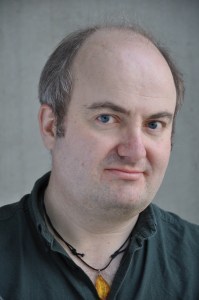 Meet Thomas Shepherd, artist and novelist
Meet Thomas Shepherd, artist and novelistI first met T E Shepherd, or Thomas as I know him, through his novels. We were both members of the Alliance of Independent Authors, and for a little while we belonged to the same writers’ group, meeting regularly in Oxford. Only after reading and enjoying his Mr Tumnal novels did I realise he was also a talented illustrator, with a style so distinctive that readers have asked me whether he is related to A A Milne‘s illustrator, E H Shepard. (As you will have guessed from the different spelling, no, he’s not!)
When Thomas started sharing some of his drawings online, in particular a picture of Hawkesbury Upton’s village school, one of the venues for the Haweksbury Upton Literature Festival that I organise each year, I asked him to create a village map to help visitors find their way around the festival, and the result was stunning.
 Hawkesbury Upton Primary School – available to buy as a greeting card also (Image © T E Shepherd http://www.teshepherdart.com
Hawkesbury Upton Primary School – available to buy as a greeting card also (Image © T E Shepherd http://www.teshepherdart.com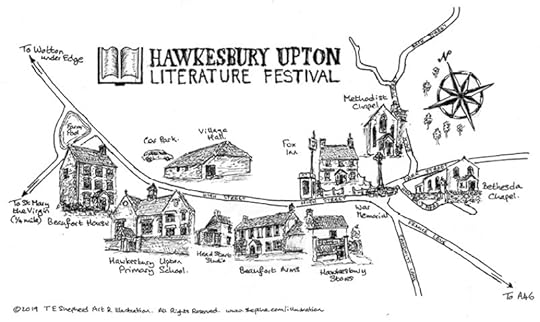 Hawkesbury Upton Literature Festival map by T E Shepherd ©T E Shepherd http://www.teshepherdart.com
Hawkesbury Upton Literature Festival map by T E Shepherd ©T E Shepherd http://www.teshepherdart.comWhen he started sharing portraits of some of his favourite bookshops, it seemed only natural to ask him whether he might also draw a fictitious bookshop for me – Hector’s House, which is at the heart of my Sophie Sayers Village Mysteries. Sophie works in the shop and the proprietor, Hector Munro, is her romantic interest.
Usually Thomas draws from life rather than from his imagination, but for me he was prepared to make an exception, provided I was able to give him a good brief and some photos of the kind of thing I was looking for.
For Hector’s House, I’d already specified certain details in the books, and needed to find a Cotswold cottage that matched that specification – harder than I’d expected! Eventually I sent Thomas a snapshot of Nailsworth Computers (highly recommended for their computer services, by the way – I’ve been a regular customer for years) plus a list of changes that would be needed to complete the transformation. I was astonished when a local friend told me later that this building used to be a bookshop. It was clearly meant to be!
 This illustration of the Hector’s House bookshop by Thomas Shepherd is in the same style as Sophie’s ficitious cottage (Image © T E Shepherd http://www.teshepherd.art.com)
This illustration of the Hector’s House bookshop by Thomas Shepherd is in the same style as Sophie’s ficitious cottage (Image © T E Shepherd http://www.teshepherd.art.com)I was so delighted with Thomas’s attention to detail and the thought that went into the drawing that as soon as my second series of novels was established, the Staffroom at St Bride’s School Stories for Grown-ups, that I asked him to draw the school building. This time his starting point was the cover design of the first book in the series, Secrets at St Bride’s, with his own personal flourishes added.
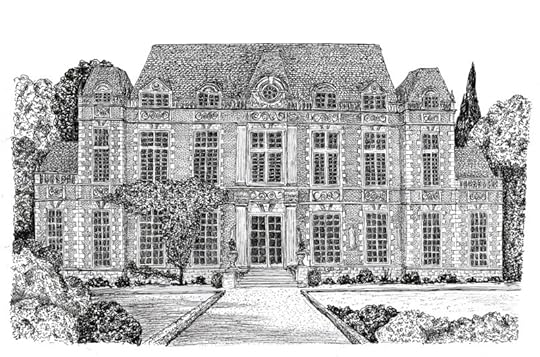 I never knew until Thomas drew it on that there was wisteria growing up the side of the building, but it looked just right! (Image © T E Shepherd http://www.teshepherdart.com)
I never knew until Thomas drew it on that there was wisteria growing up the side of the building, but it looked just right! (Image © T E Shepherd http://www.teshepherdart.com)When I started my spin-off series of quick-read novelettes set in the same parish as these two series, Tales from Wendlebury Barrow, I couldn’t resist completing the set by commissioning Thomas to draw the Wendlebury Barrow village green, which features in all three series. Again I found myself driving round the Cotswolds looking for appropriate visuals for him, and ended up sending a selection of different greens from which he took various elements to create a completely new one just right for me stories. He even added Sophie and Hector!
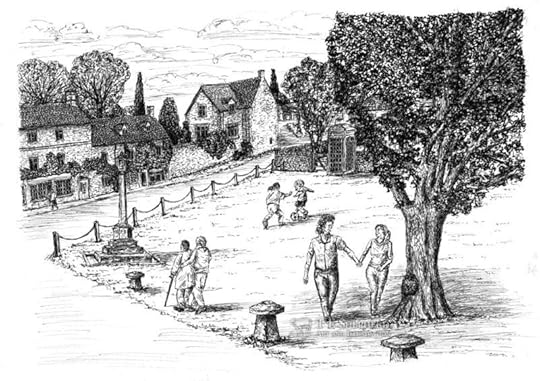 A glimpse of some of the characters who inhabit my novels (Image © T E Shepherd http://www.teshepherdart.com
A glimpse of some of the characters who inhabit my novels (Image © T E Shepherd http://www.teshepherdart.comI now have framed prints of all three on my study walls to help me immerse myself in these worlds as I write my stories. I’ve also turned the first two into attractive cards and bookmarks to give away to readers at events, and will be doing the same with the third once we’re allowed to hold in-person events again. I’m also planning to add the appropriate drawing to the interior title page of each book so that all my readers may enjoy them,
As is usual with such things, the copyright remains with the artist, and anyone wishing to order prints from him or to book commissions of their own should contact him via his website: www.teshepherdart.com. He has a different website about his books: http://www.shepline.com/books.
He also sells prints of his other landscape drawings of bookshops and historic buildings, and this year produced for the first time a calendar of his art. There are still a few copies available to buy in his January sale on his website here
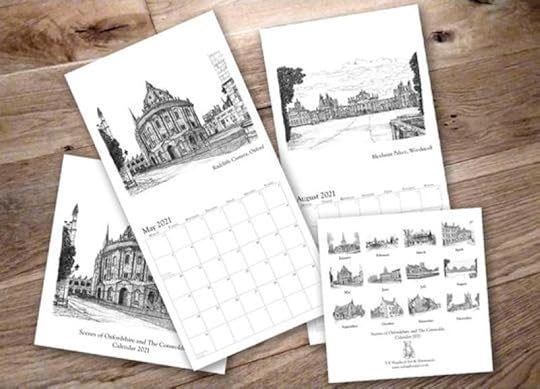 Still a few copies for sale on Thomas’s website
Still a few copies for sale on Thomas’s websiteI’ll be holding a prize draw for a copy of the calendar for my Readers’ Club in my next newsletter which I’m planning to despatch tomorrow. If you’d like a chance to win one and you’re not already a member, you can join my Readers’ Club here. There’s a different prize draw every month for something fun associated with my books.
But that’s enough about me! Now here’s a chance to get to know more about Thomas and his work via this exclusive interview that he kindly gave me a few days ago.
Exclusive Interview with T E Shepherd, Illustrator & Novelist Meet Thomas Shepherd, artist and novelist
Meet Thomas Shepherd, artist and novelistThomas, welcome to my blog – I’m so pleased to be able to introduce my readers to the man behind the drawings! When did you take up drawing and how has your career progressed?
I’ve always drawn, for as long as I remember. Give me a pad of paper and a pack of those cheap felt tip pens from the post office or Happy Shopper on the corner and I am lucky. At college I was never that great at taking notes in lectures because I’d be doodling patterns on my notepad instead. I did art at college, specialising mainly in photography and printmaking which I loved, however since leaving college I of course lost access to the dark room (this was almost a decade before digital cameras) and it’s hard to set yourself doing printmaking. I also left college thinking that my kind of art wasn’t really that good because it wasn’t the weird stuff you find art galleries winning awards! It wasn’t until I was fortunate to be working the day job with the fantastic Rachel Henderson Art that she encouraged me into doing things with my art.
Please describe the media you work in and the processes involved in creating a new drawing.
I work mainly in Indian Ink although I also use coloured pencils. I have been known though to work in photography, printmaking, airbrush, gouache – basically it depends what the picture is that I’m doing!
Why do you particularly enjoy drawing buildings?
The honest answer is that I have historically been terrible at drawing people! The slightly more interesting is that they interest me. It has to be said, I have a bit of thing for cobbles, walls, and doorways. My A-Level art exam piece was a piece created from the subject “Through doorways” in 10 hours, or two back to back days.
For this year you produced a calendar of your favourite drawings of Oxfordshire and the Cotswolds. What makes this region particularly rewarding for you as an artist?
Simple answer really that I live in Oxfordshire on the doorstep to the Cotswolds and that is the geographical area that I have mainly been selling my work, at markets, when markets are allowed to happen. I grew up in East Anglia though and still have strong links there so I could have done the East Anglian. Collection (following on in the footsteps of John Piper I already have three Suffolk churches to my name!). When you include all the bookshops of I’ve drawn it puts my geographic spread is even wider.
What else do you like to draw?
Anything and everything that interests me. I’m a very visual person – even when I’m writing my books it’s the frame by frame cinematic scenes that I’m picturing as I write. And so if I see a view or frame a picture in my gaze I want to capture it, often with a photo (or two, or three…) ahead of drawing them.
Tell us about your passion for bookshops and why you love drawing them.
As mentioned above, I write books. My degree, as well visual arts also involved creative writing, and I’ve written three novels to date: my debut standalone book, and the first two parts of a trilogy about imaginary friends. I love books, and stories – I have a ‘library’ of over 2000 books in the house. If I visit a town and there’s a bookshop, I can’t not go in, and chances are I will buy at least one book, so yes you could say that bookshops are bad and evil places for me to visit… *grins*
I have an on-going project to illustrate myself around the country drawing (mostly) independent bookshops for my celebration of bookshops in my my illustrated The Booklover’s Guide to Bookshops.
What is the most challenging picture you’ve ever drawn and why?
My most challenging picture that I had to draw was my illustration for Tales of the Wendlebury Barrow. Not only was this to be an imaginative piece but it needed to include a traditional village scene of people and to be honest people have never been my strong point. My two big inspirations are the work of Rex Whistler and Edward Ardizzone and I’ve found my style to be somewhere in between. One of the things I love about Ardizzone’s illustration is the way they are very loose simple designs but have all the character and expression. It was a challenge, but one that I believe I pulled off, particularly when the author saw her two lead characters come walking out of the picture towards her.
Previous to that, one my biggest challenges was a pen and ink and colour illustration I did of Bolton Abbey in Yorkshire. I was established in the medium of black and white, so adding colour was a bit of a departure, but one that was really effective and led directly to a commission late last year of a full colour picture of Notley Abbey as a wedding anniversary present.
Which is your favourite of all the pictures you’ve done and why?
If I had to choose just one, it would be my picture of St Andrew’s Church, Covehithe in Suffolk. Covehithe is one of my most favourite of places in the world with some very fond memories for me. There is a poignancy to the place as it probably has no more than 60 more years before the fragile Suffolk coast tips it into the sea. Sadly I don’t have the original any more as it was snaffled up within days of me finishing it but I know that it went to a new home.
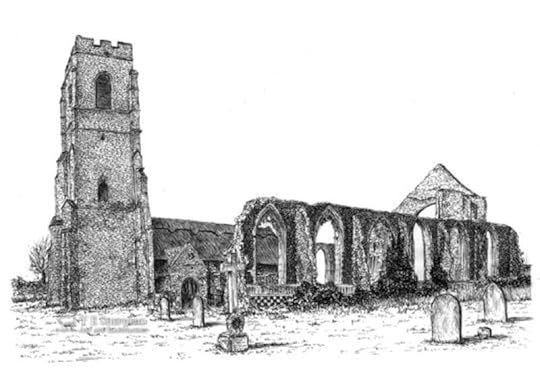 Thomas’s favourite illustration – St Andrew’s, Covehithe, Suffolk (Image © TE Shepherd http://www.teshepherdart.com)
Thomas’s favourite illustration – St Andrew’s, Covehithe, Suffolk (Image © TE Shepherd http://www.teshepherdart.com)I know you take other commissions too – what does this entail and how do people go about commissioning a picture from you?
In short, just get in touch! I work from photographs so geography is no obstruction to having a commission done. What I do need is high resolution photos that I have permission to use. These can be photos either that you have taken or from a professional photographer so long as you have obtained copyright permission for me to work from them. I can’t use photos that you’ve grabbed from Google! My pricing is based on size of the finished work not by number of scenes, so you could have multiple views of your subject in one picture, and you pay for it upon completion of the piece when you are happy with it.
You’re not only an artist but an author too – please tell us a little about your books.
My books are what I would call real-world fantasy or magical realism. My debut novel is set in Iceland and is a story where Norse Mythology meets modern day climate science as our protagonists face The End Of All Worlds. My other two books are the first and second books in my Imaginary Friends trilogy. The first in the series, Mr Tumnal, concerns a man, Louis Tumnal who marries his imaginary friend and has an imaginary child. When he meets his real-life girlfriend things get complicated beyond imagining.
What are you working on at the moment – both in terms of drawing and writing?
I’m currently writing the third book in the trilogy, Forgotten Friends, set 40 years after the events of the first book in a post-technological world (imagine consulting Wikipedia in print in a vast room underground Oxford’s Bodleian Library!) With my drawing, I had a crazy end to last year, finishing my last commission a day before delivering it to my client on Christmas Eve and so I’m taking January off – partly this is because I incurred a drawing-induced injury of trigger finger! But I have been creating art, having acquired a press to get back to etching too, which is something I’m very excited about.
Where can people go to find out more about your illustration and your books?
The best way to find out about my illustration work is on my online shop: www.teshepherdart.com but you can also find me on Instagram and Facebook at @t.e.shepherd.art. My books, can be found at www.shepline.com/books or follow me on Twitter at @shepline.
Biography of T E ShepherdDerbyshire born, Suffolk bred. Thomas Shepherd now lives in Oxfordshire with his wife Emma and five cats, five chickens, three bunnies, two African land snails and some fish. He’s a landscape artist and novelist. His two main inspirations are the work of Edward Ardizzone and Rex Whistler, and his style is somewhere between the two. As a published author, books are his passion, and he is currently working on a project to create an illustrated guide of bookshops. He works principally in Indian Ink and Polychromos artists’ pencils. He takes commissions, including maps and book illustration.
Find Out More About T E ShepherdFor more about Thomas’s art, visit: www.teshepherdart.com.For more about Thomas’s novels, visit www.shepline.com/books.Follow him on Twitter at www.twitter.com/shepline.Like his Facebook page at www.facebook.com/t.e.shepherd.artFollow him on Instagram at www.instagram.com/t.e.shepherd.art.
January 15, 2021
The End of an Era: The Chronicle of an Extraordinary Five Years
 My latest book has just been launched to mark 30 years of life in Hawkesbury Upton
My latest book has just been launched to mark 30 years of life in Hawkesbury UptonAs regular readers of this blog will know, once a month I share here my latest column for the Hawkesbury Parish News, our local community magazine that is possibly the best-read journal in our little Cotswold village of Hawkesbury Upton, the real-life village that inspired my Sophie Sayers Village Mystery novels.
If you’ve been following my blog for more than five years, (and if so, gold star to you!), you may also recall that I gathered together my earlier columns into a book called All Part of the Charm. The columns in that book ran from January 2010, when I gave up my last full-time day-job to write, through 2015. I also included some essays I wrote about moving to the village in 1991.
As the end of 2020 was approaching, being a fan of round numbers, and also to celebrate 30 years of living in Hawkesbury Upton, I decided it was time to collate my next batch of columns into a new book – 60 columns in all, one each month from 2016 to 2020. Rereading them to refresh my memory of their content before writing the introduction, I realised what an extraordinary five years they had been, and how much change – turmoil, even – they had brought to our lives. Yet throughout my columns, written for a local audience in our small corner of the Cotswolds, ran a common thread:
In an ever-changing world which seems to be lurching from one crisis to the next, it’s comforting to have some events in life that are dependably consistent – and to live in a community in which everyone looks out for their neighbours, not only in the season of goodwill, but all year round.
Wherever you are in the world, if you’d like to feel like an honorary or adoptive member of the parish of Hawkesbury, reading this little book will take you there as surely as the back of a certain wardrobe transports us to Narnia.
Below I’m sharing the introduction I wrote to this new book, which you can order now in ebook and paperback.
The ebook goes live on Amazon on 18th January (chosen as it’s my birthday, big kid that I am!) and is already available on other ebook platforms.The paperback is now available from Amazon at a special launch price of £3.99 or equivalent in your local currency until the end of January.It’s a slimmer book than the first volume, as it doesn’t include any additional essays, and I’ve changed the layout to be less extravagant with paper, but I hope you’ll think it’s great value at that price – and that you will be what it says on the cover: still charmed.
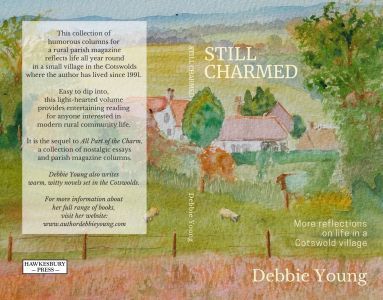 The watercolour by my talented father has already been much admired by friends onlineForeword to Still Charmed:Thirty Years On
The watercolour by my talented father has already been much admired by friends onlineForeword to Still Charmed:Thirty Years OnThis week, in celebration of 30 years since moving to the Cotswold village of Hawkesbury Upton on 4 January 1991, I dug out my old diary to revisit my initial impressions of village life, starting with a hectic first day in our new home.
“The log man came, bringing 15 sacks of logs, then the sweep came and cleaned both chimneys amazingly cleanly. I’d expected him to be covered in soot. Felt a little out of place when I realised that not only was I straining to understand his accent, but he was straining to understand mine.”
Next day, my husband “went to the shop for eggs and bread. Lots of people friendly there – one man knew he was from the old post office already.”
The house, unoccupied for eighteen months before we bought it, was somewhat spartan, the only heating provided by a vintage single-bar electric fire in the bathroom and an inefficient open fireplace in the front room. For several weeks, we slept on the floor in front of the fire, as everywhere else was too cold and damp. But by the second day, I was already acclimatising to our new home, a mid-nineteenth century stone cottage:
“Even though it seems in some respects that we’re roughing it, the convenience and comfort are infinitely greater than they would have been for the original occupants. When I put off going to the loo here as it’s so cold and damp, I ought to remember they would have gone down the bottom of the garden to the privy.” (Two outdoor toilets, buckets beneath holes in wooden planks, were still intact when we moved in.) “I understand the attraction of chamber pots for the first time.”
In the intervening 30 years, the house has been transformed to modern standards of comfort while we’ve retained many original features and added whimsical new ones of our own. My husband is building a mezzanine floor above the kitchen as I write. We’ve also become completely immersed in village life and are charmed by it.
During that time, I’ve served on many committees and volunteered for various community organisations in one way or another, and for the last 11 years, I’ve been writing a monthly column for our local parish magazine, the Hawkesbury Parish News, which, despite our village now boasting a high-speed internet connection, is just as much the hub of local news as it was when I first moved here. If you want to know about events, developments, future plans, and the traditional hatches, matches and despatches in our community, all you need to do is invest 50p a month in the parish mag, a fee that also includes optional delivery to your door. These days, electronic delivery is also available.
Although I often write articles for the various local organisations I’m involved in, such as the annual Hawkesbury Upton Literature Festival which I founded in 2015, my monthly column has no particular brief. I just write about whatever is front of mind as the deadline looms, which is usually seasonal or otherwise topical. The aim of my contribution is to entertain, amuse, divert and share experiences that I think will make my local friends and neighbours smile. There are plenty of jokes at my own expense, and my chosen topics are often village-centric.
But although Hawkesbury Upton is surrounded by fields and reached only by winding country lanes, most of them single track, our rural idyll does not escape the harsh realities of the outside world. The period this volume covers began in the run-up to the EU referendum and ended literally on the day we in the UK left the European Union. One of the last things I did in 2020 was apply for a new passport, as my old one was due to expire on 2 January 2021. The new one will be blue, not red, and will not bear the words European Union on the cover.
Also, as I wrote the first column shared here, the US presidential election that resulted in a win for Trump was in full swing. As I wrote the final piece, Biden’s victory was assured.
Collating these columns for the collection last week, I gasped when I realised the first entry would be titled “Flu Fury”, a jokey piece written while I was on the mend from a dose of winter flu. I’m glad I didn’t know then about the coming Covid-19 pandemic, nor the disruption and devastation it would bring to the whole world. Even Hawkesbury Upton, tucked away in the Cotswolds, with its moat-like surround of agricultural land, has not escaped unscathed, and my heart goes out to all those who have lost loved ones or suffered long-term health complications.
During this extraordinary five-year period, I have lost count of the number of times I have said to my daughter while watching Trump supporters invade the Capitol, “Take note of this, we’re witnessing history in the making”, and last night, as I was planning what to write in this foreword, I said it again.
This time, she replied in her teenaged wisdom, “Everything is history these days”.
Yet truer than ever are the pieces I’ve written celebrating the joy of coming home to Hawkesbury after holidays away and my gratitude for living “in a community in which everyone looks out for their neighbours, and not only in times of crisis or the season of goodwill”. (Who Needs Wifi When You’ve Got Good Neighbours, January 2018). I also often remark upon the continuity of village life. “In an ever-changing world which seems to be lurching from one crisis to the next, it’s comforting to have some events in life that are dependably consistent.” (The Comfort of Consistency, July 2019)
During the pandemic, we may have lost the events that provide the consistency – the Hawkesbury Horticultural Show, the Hawkesbury Upton Literature Festival, the midnight carol singing on Christmas Eve – but the community spirit is stronger than ever, not least due to the continuing presence of the Hawkesbury Parish News, which appeared as regularly as ever throughout lockdown, a comforting dose of normality in the midst of the most abnormal of years. In the absence of events news to fill the pages, the editor, Colin Dixon, persuaded more villagers to write articles, reproduced copy from the archives, and kindly shared extracts from my novels to help keep people entertained.
On a brighter note, the five years represented in this volume have included the culmination of my lifelong ambition to become a novelist, with the first of my eight novels published so far unveiled on 1 April 2017. It may have been no surprise to anyone familiar with my columns that my novels have been inspired by my delight in village life, although I hasten to add that all the characters, settings, and situations in my Sophie Sayers Village Mysteries, my Staffroom at St Bride’s series, and my Tales from Wendlebury Barrow Quick Reads are entirely made up. So if you enjoy reading these columns, you should find my novels just your cup of tea – and vice versa. (You’ll find a full list of the novels published so far in the back of this book, and there are plenty more to come.)
Now writing my ninth novel, and with the deadline of my 134th column for the Hawkesbury Parish News looming, I’m grateful for the enthusiasm and support of its readers and production team spurring me on. First Fiona Rowe and now Colin Dixon have worked tirelessly and meticulously, with the support of a hardworking and efficient team behind the scenes, to take the magazine from strength to strength, growing it thicker and more interesting each year. Whatever history has in store for us, I will be proud to write for the Hawkesbury Parish News for as long as I am able, and may it forever be a source of comfort, entertainment and pleasure to its readers.
Debbie Young
January 2021
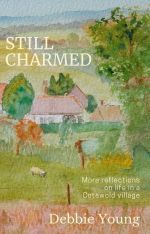
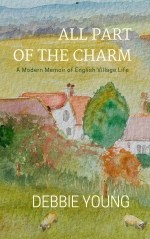
Click here for more information about my Sophie Sayers Village Mysteries
COMING SOON: Travels with my Books – a new monthly series of guest posts by authors talking about the setting for their novels
First on the list: B M Allsopp, author of the Fiji Islands Mysteries – follow my blog (click button in the sidebar to the right of this post), if you don’t already, to make sure you don’t miss this intriguing exclusive interview!
January 6, 2021
Planning for a Better Year
In my first column of 2021 for the Hawkesbury Parish News, I wrote about the art of planning ahead – or, more accurately, my life as a Last-minute Martha.
As the editor of the Parish News will no doubt agree, I am something of a last-minuter. Ever since I started work as a journalist back in the 80s, nothing makes me as productive as a deadline. Above my desk hangs a framed Posy Simmonds cartoon strip I cut out of The Guardian back then, featuring a hapless hack racing to meet a copy deadline and doing everything but writing. She meets friends at a wine bar (well, this was the 80s), takes clothes to the dry cleaners, and washes her hair, while accruing sympathy from her friends about the pressure of her wretched deadline. She submits her piece to her long-suffering editor at absolutely the last minute, having pulled an all-nighter, garnering further sympathy from her gullible husband.
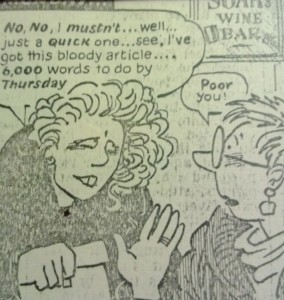 (c) Posy Simmonds
(c) Posy SimmondsRemembering the Filofax
Inspired by that cartoon for over thirty years (so much so that I named my first cat Posy – Ms Simmonds was very pleased when I told her, after I’d heard her speak at the Cheltenham Literature Festival), I’m always pleased to discover a new method of planning my workload more effectively. I’ve tried everything from the Filofax (another craze from the 80s, when we had to file copy by telex and fax to our head office) to an electronic diary. None of these methods have lasted long. Although I’m comfortable with computers, at heart I am a low-technology girl.
More recently, I tried this tip: let your daily to-do list be no longer than would fit on a Post-it Note. My solution: buy bigger Post-it Notes.

Buying into the Bullet Journal
Then I discovered the Bullet Journal, invented by Ryder Carroll. (Watch his free four-minute tutorial here.) refuse to use the affectionate abbreviation of BuJo that many users prefer, because it reminds me of our Prime Minister’s nickname, which distracts me from any thoughts of efficient planning.
The Bullet Journal starts life as a blank notebook, preferably dotted so you can draw grids for various lists. It includes an index at the front to keep track of the lists you create, such as books to read, creative ideas, and long-term goals, as well as daily, weekly, monthly and quarterly to-do lists. A key provides an appropriate symbol so you can see at a glance how your day is shaping up: a bullet point (no surprises there) for a task, a circle for an event, and so on. You number the top three priorities and put a cross through items as they are completed, so it’s easy to see progress.
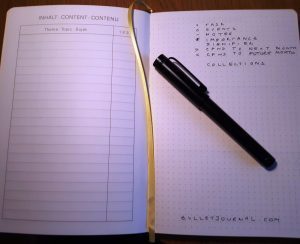
So far so good, until I discover one more recommended symbol, a forward arrow named “task migration”, indicating an item to be moved to the next day. In my head, I’ve already labelled it the mañana option – Spanish for “an indefinite time in the future”. So much for deadlines!
But with a year like 2020 behind us, planning no longer seems relevant. In 2021, let’s just seize the day, take our pleasures where we can find them, and do the best we can. If what I do happens to feature on my daily to-do list – like writing this column – I’m counting that as a win.
Wishing you a very happy and healthy New Year, however you plan to spend yours.
IN OTHER NEWS
 Coming soon!
Coming soon!New Non-fiction Book Out Soon
This week marks my thirtieth anniversary of moving to Hawkesbury Upton. To celebrate, I’m working on Still Charmed, the second volume of my collected columns from the Hawkesbury Parish News, which I hope to publish as an ebook and paperback later this month. I’ll announce it here when it’s ready to order, but in the meantime, here’s the cover, featuring a watercolour by my talented father. (The first collection, All Part of the Charm, featured another section of the same painting.)
New Novel Bubbling Under
I’m also working on the seventh Sophie Sayers novel, Murder Lost and Found, which I’m hoping to publish in the spring.
99p Offer on Murder by the Book
I’ve currently got a special seasonal offer running on the fourth Sophie Sayers novel, Murder by the Book, with the ebook just 99p/99c or local currency equivalent until the end of the month. (Also available in paperback at the usual RRP.) This story takes place from the start of January and finishes on Valentine’s Day, when Sophie and her friend Ella plan to hold an event to help stop the village pub, The Bluebird, from going bust – an especially topical theme right now when so many pubs are struggling to survive the pandemic. Revealing fun surprises about Hector’s past, and with the addition of two lively new characters who are siblings to regulars in the series (no plot spoilers here!), Murder by the Book is the perfect pick-me-up for these dreary, dark days and long nights. Click here to order the ebook from the ebook store of your choice and click here to order the paperback.
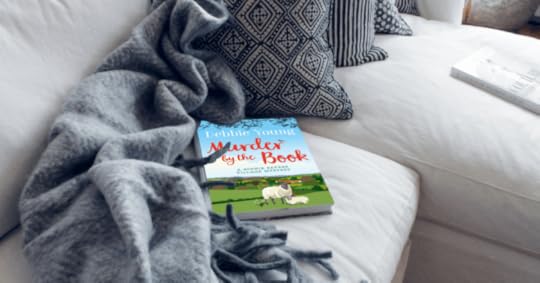 Cuddle up with a book this winter
Cuddle up with a book this winterb
January 1, 2021
With the Wisdom of Hindsight at the Turn of the Year
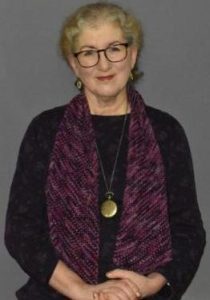 Glad to see the back of 2020
Glad to see the back of 2020(Photo by Laura Young)
One of the most important things I learned in 2020 was that it is very easy to lose perspective when so much of my life feels out of control.
When a flurry of friends shared end-of-year posts in which they realised 2020 had been more rewarding than it had seemed at the time, I recognised the same was true for me.
At the end of 2019, I was sure that 2020 could only be better. Quite apart from political and environmental disappointments (no need to go into those here), the old year had brought me two major health crises. Two scary dashes to hospital with breathing difficulties just after Christmas had led to a new diagnosis of asthma, on top of a year-long debilitating flare of my rheumatoid arthritis that was not responding to treatment.
Thwarted Plans
I had lots of exciting plans to look forward to in 2020, including the annual Hawkesbury Upton Literature Festival that I run in my home village, The Selfies Awards ceremony at the London Book Fair for which my novel Secrets at St Bride’s was shortlisted, and some interesting speaking engagements at various writing retreats and conferences around the country. Then along came the pandemic.
That annual rail pass I bought in January 2020 is about to expire unused.
Confined to my home by the need to shield due to the immunosuppressants I take for the arthritis (thankfully new ones from February 2020 brought a vast improvement), I felt thwarted, and I struggled to write as much as I thought I should be writing, given the lack of distractions. As a last resort, I set up an unfinished novel on pre-order on Amazon, the deadline forcing me to work flat out to finish it.
Cast Away
Even so, I felt like a castaway, marooned and powerless – a modern-day Robinson Crusoe, albeit with a regular supermarket delivery slot, cats in place of goats, and a husband and daughter instead of Friday for companionship. So while I was hardly deprived, sometimes I couldn’t stop my gaze lingering on the horizon, hoping for signs of rescue. Although one might think this would have been the perfect time to write my planned travel memoir, Travels with my Camper Van, after several false starts, I set it aside, disappointed that it had stalled.
A Surprisingly Productive Year
However, with the wisdom of hindsight that New Year’s Eve brings, I now realise that in 2020 I was far more productive than I had been in 2019, when I published just one novel, Secrets at St Bride’s.
By contrast, in 2020, I wrote two more novels, Stranger at St Bride’s and Murder Your Darlings; the first two in my new series of Tales from Wendlebury Barrow Quick Reads (c. 20% novel length), The Natter of Knitters and The Clutch of Eggs; and the first Sophie Sayers prequel, a short story Christmas Ginger, featuring Sophie’s Great Auntie May.
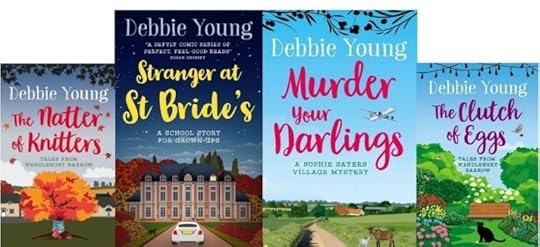 New fiction in 2020
New fiction in 2020As I’ve done every year since 2010, I also wrote 10 columns for the Tetbury Advertiser and 12 for the Hawkesbury Parish News. In addition I completed the first two articles in a newly commissioned series of eight for Mslexia (the magazine for women who write), a short non-fiction guidebook for the Alliance of Independent Authors, plus various blog posts for my own blog and as a guest writer on other sites.
By anyone’s standards, that’s productive.
Writing in Captivity
Only now as I’m writing this post does it occur to me that prison has proven a famously fruitful workspace for writers. Miguel de Cervantes’ Don Quixote, John Bunyan’s Pilgrim’s Progress, and Sir Thomas Malory’s Le Morte d’Arthur were all written in jail. (More examples are in this Guardian article, though not all are such great role models – Marquis de Sade, I’m looking at you!)
Buoyed Up for New Year
So as I ditch my old 2020 calendars and diaries, I’m going to focus on even more ambitious productivity goals for the new year:
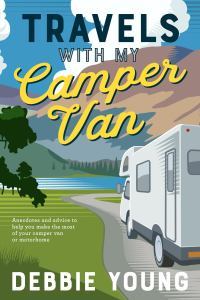 Look out 2021, here I come!
Look out 2021, here I come!a new Sophie Sayers novel, Murder Lost and Found
a new St Bride’s novel, Scandal at St Bride’s
a new trilogy of May Sayers short stories, May Sayers Comes Home
in time for Christmas 2021, The Wendlebury Barrow Christmas Compendium of short seasonal stories
a third Tale from Wendlebury Barrow (haven’t decided which from my bulging ideas book yet)
Travels with my Camper Van, now jumpstarted
So look out, 2021, I’m coming for you!
Whatever your plans are for the new year, I wish you a peaceful, healthy and happy one full of whatever your heart desires.
In the meantime, if you haven’t yet read my new short story Christmas Ginger, which was published on 24th December 2020 exclusively on Helen Hollick’s Discovering Diamonds blog, you can read it here for free, for a flavour of my planned 2021 short story trilogy, May Sayers Comes Home.
December 24, 2020
Christmas Ginger – a New Christmas Story Free to Read Now (The First Ever Sophie Sayers Prequel!)
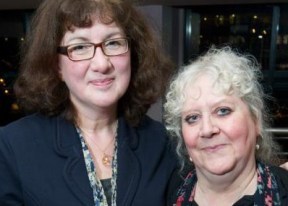 With Helen Hollick, novelist and founder of the Discovering Diamonds blog
With Helen Hollick, novelist and founder of the Discovering Diamonds blogToday I’m pleased to share with you Christmas Ginger, a heartwarming festive short story that I’ve written for novelist Helen Hollick‘s Story Song series, in which during December a different story inspired by a song is published each day on her Discovering Diamonds blog.
Christmas Stories Past
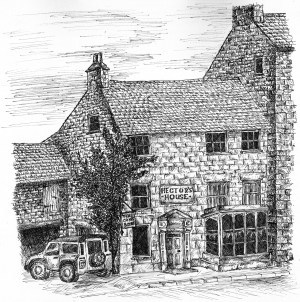 Hector’s House was the scene of last year’s Christmas story (Copyright Thomas Shepherd http://www.shepline.com)
Hector’s House was the scene of last year’s Christmas story (Copyright Thomas Shepherd http://www.shepline.com)The first story I wrote for Helen’s blog was Lighting Up Time, set at the winter solstice, and since published as an ebook, audio short, and a tiny paperback the perfect size for a stocking filler.
Last year my contribution was a short story called It Doesn’t Feel Like Christmas, set in the Hector’s House bookshop, featuring Sophie, Hector, Billy and other favourite characters from my Sophie Sayers Village Mysteries. You can read that one here – and see whether you can guess before the end which song inspired the story! (This one hasn’t made it into a book yet, but will be included in my planned Wendlebury Barrow Christmas Compendium in 2021.)
Christmas Story Present
 One of May Sayers’ many souvenirs from her travels – a South African Christmas angel
One of May Sayers’ many souvenirs from her travels – a South African Christmas angelFor this year’s series, I decided to write a story I’d had in my head for a while: the return of Sophie’s late great-aunt, May Sayers, to live in the cottage that she’ll eventually leave to Sophie.
In this story we find May unexpectedly alone for Christmas, in a scenario that sadly so many people will face this festive season. Then an unexpected visit from her old friend Billy inspires the ever-resourceful May to use an old-fashioned trick to transform her lonely vigil into her most special Christmas ever.
Whether or not you’ve read any of the Sophie Sayers Village Mysteries yet, I hope you will enjoy this gentle Christmas tale.
Christmas Ginger has not yet been published anywhere else. so for now the only place you can read it is on the Discovering Diamonds website:
Christmas Stories Yet to Come
By Christmas 2021, I’m planning to publish The Wendlebury Barrow Christmas Compendium. One of my projects over this holiday season is to write another new story inspired by the poinsettia – which I’ve just discovered rather pleasingly is named after one Joel Poinsett. More of that to follow in my story next Christmas!
Also in the new year I’m planning to write a trilogy of short stories, May Sayers Comes Home, as well as a new novel in each of the Sophie Sayers and St Bride’s School series. I’m going to be busy!
For now, have a peaceful and restorative Christmas, and I’ll look forward to catching up with you here on my blog at the end of the year.
My Other Books with a Christmas Theme
(all available in paperback and ebook – click images for ebook store links)
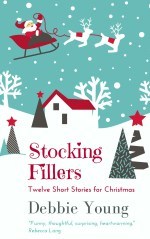 The perfect antidote to Christmas stress
The perfect antidote to Christmas stress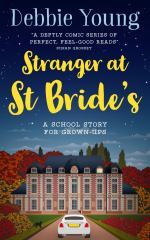 A gentle mystery solved at the School Christmas Fair
A gentle mystery solved at the School Christmas Fair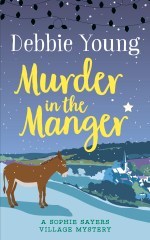 When Sophie’s nativity play goes wrong…
When Sophie’s nativity play goes wrong…



